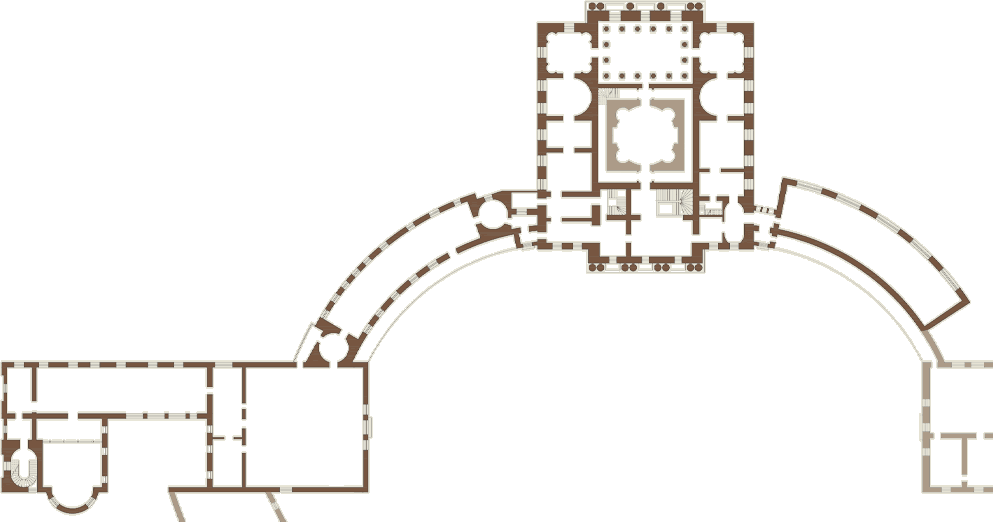The Knights Room
Загрузка панорамы...
The Knights Room, or the Antechurch Gallery, was decorated by the architect Vincenzo Brenna in 1797–1799 during the expansion of the palace, which became the Imperial residence. This state hall was intended for ceremonial receptions, and sometimes for dinners. The architectural solution of the hall is extremely simple: it has the shape of an elongated rectangle with alternating windows on the long sides. Artistically, it is conceived as a gallery of antique sculpture. Along the entire perimeter of the hall, there are reliefs depicting various processions in the form of a frieze punctuated by windows and doors. The reliefs were made by sculptors Ivan Prokofiev and Mikhail Aleksandrov-Uvazhny inspired by reliefs of Roman sarcophagi. Two more belts of ornamental molding are placed under the reliefs. The ceiling painting in greenish tones, imitating molding in the grisaille technique, also remains in a single ensemble with wall decoration. In the ceiling painting, special attention is drawn to the images of two shields carried by the goddesses of glory. The one has St. George the Victorious, the old Russian symbol of the power of the Grand Dukes of Moscow. The other has the Maltese cross. The appearance of the Maltese cross is because Emperor Paul I took the Knights of the Order of Malta under his protection when Napoleon expelled them from the island of Malta. In 1798, the knights proclaimed Paul I the protector of the Order, and then the Grand Master, so the image of the Maltese Cross became part of the Russian state symbols. The hall was named the Knights Room since receptions were held here in honor of the Knights of the Order of Malta.
The main element of the decoration of the room is a collection of antique sculptures. Such “halls of antiquities” were a necessary accessory of many Russian palaces of the 18th century, when a special interest in the art of the ancient world sparked, caused by the excavations of the ancient cities of Pompeii and Herculaneum in Italy, which prompted patrons to collect antiques. The owners of Pavlovsk also had their own antique collection, acquired during their trip to Italy in 1782. Initially, eight statues (ancient Roman copies from Hellenistic originals) were placed in the room. All of them are of the same size as they were explicitly selected from the John Lyde Browne's collection purchased by Catherine II for Tsarskoye Selo. Eight statues on pedestals of pinkish-brown natural marble, set evenly against the background of the walls, like a colonnade, determined the main architectural rhythm of the hall, which was supported by busts on blue pedestals towards the end walls. Their rhythm was completed by two large marble vases with bas-reliefs (in front of the wall on the Orchestral Room side) and two round faience stoves with bas-reliefs in the corners of the opposite narrow wall.
In 1872, the owner of Pavlovsk, Grand Duke Konstantin Nikolaevich, the grandson of Paul I, opened the Museum of Antiquities in the palace, and the Knights Room was turned into the Antique Gallery. Currently, along with the statues from the collection of Catherine II, there are Roman ash urns in the hall, some of which were purchased by Pavel Petrovich, and four large statues: Nymph with a Shell (a fountain statue), A Roman in a Toga" (Togatus), Empress Faustina the Younger in the Role of Venus and Resting Satyr. The last three are among the best works of ancient Roman plastic art.
The Knights Room on the floor plane
- The Egyptian Vestibule
- The Carpet Study
- The Second Interconnecting Study
- The Main Staircase
- The Hall of War
- The Picture Gallery
- The Upper Vestibule
- The Greek Hall
- The Third Interconnecting Study
- The Italian Hall
- The Hall of Peace
- The Throne Room
- The Valet de Chambre Room of Paul I
- The Library of Empress Maria Feodorovna
- The Pantry
- The Dressing Room of Paul I
- The Boudoir
- The Orchestral Room
- The Rossi Study
- The State Bedroom
- The Knights Room
- The Rossi Library
- The Dressing Room of Maria Feodorovna
- The Chevalier Guard Room
- The Small Study of Emperor Paul I
- The Maid of Honour's Room
- The Anteroom (Turkish Room)
- The State Library of Paul I
- The First Interconnecting Study
- The Palace Church

Back
